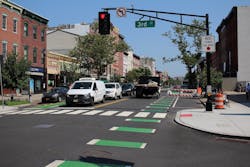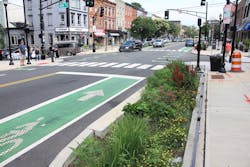By: Don Di Zuzio and Peter Bondar
For more than a century, the bustling thoroughfare known as Washington Street has cut a path through the city of Hoboken, New Jersey, on the banks of the Hudson River.
In 1846, the first organized baseball game was played at Hoboken’s Elysian Fields; today, a painted baseball diamond at the 11th Street intersection marks the spot. As the new century approached, horse-drawn carriages were joined by a trolley system and eventually, the first automobiles. Some years later, a relatively modern innovation—an automated traffic signal, featuring the newly invented yellow “caution” light—was installed at the intersection of Washington and 1st streets. Ford Model Ts and streetcars rolled past furriers and livery stables.
Over the decades, Hoboken grew. The Holland and Lincoln tunnels were built, opening new channels for traffic to Manhattan. World War II fueled the industrial economy. In recent years, gentrification has brought new families and New York City commuters to Hoboken, now among the country’s most densely populated cities.
And through it all, as increasing numbers of cars and buses packed the city’s thoroughfares, that same antique streetlight on Washington Street continued to burn red, yellow, and green.
In the summer of 2015, Hoboken officials reached out to numerous companies in connection to the New Jersey DOT’s Complete Streets program. The goal was to modernize Washington Street and make it safer and more accessible for all users—not only the street’s 9,000 daily drivers, but also its 14,000 bus riders and 18,000 pedestrians. As part of this effort, T&M Associates was engaged for a complete redesign of Washington Street.
Once named by the American Planning Association among the nation’s “10 Great Streets,” the decades had taken their toll on Washington Street. Traffic signals were outdated, resulting in increased collisions and dangerous conditions for pedestrians. The roadway, featuring two lanes of opposing traffic, had no accommodations for bicycles, and was frequently throttled by deliveries and trash pickups. Hurricane Sandy and other major rainstorms were a painful reminder to city administrators that the aging sewer system was overtaxed. The water infrastructure was a century old, and critical facilities lacked emergency backup power. Frequent double-parking and reduced pedestrian sight-distances added further complications.
As the project’s transportation engineer and construction manager, T&M Associates oversaw a comprehensive rehabilitation that began with a traffic assessment—both an in-the-field study of traffic counts and patterns, and analyses using software tools like Synchro 10. It became clear that traffic signals were not optimized, and that accommodations were needed to make curbs and crossing areas safe for pedestrians and the visually impaired.
At long last, the antique traffic signal—believed to be among the oldest continually operating models of its type in the U.S.—was given a well-deserved retirement. Improvements to the site, made over the course of two years, included a roadway rehabilitation and the installation of 14 state-of-the-art signals with GPS timers and pedestrian countdown indications. Due to a slight narrowing of the intersections caused by necessary curb extensions, signal preemption features were incorporated to facilitate emergency vehicles. And dedicated loading zones and color-coded bus stops were added to decrease congestion.
Because the focus of complete streets is safer and more accessible streets, this meant balancing the needs of all travelers. No easy task, but we worked closely with city officials, businesses, and residents to find compromises. In addition to high-visibility crosswalks and ADA-compliant traffic signals with audio cues, we also added lead pedestrian intervals, a new industry practice that gives people in crosswalks a head start before parallel traffic can make turns. Dedicated bike lanes with green, high-visibility pavement markings were added, along with back-in parallel parking spaces for improved pedestrian safety.
The redesign went well beyond traffic improvements. We oversaw the installation of one of the country’s first municipal electrical microgrids, which will supply redundant power to critical facilities. 9,000 linear ft of water mains were replaced, and the antique water distribution system was upgraded to include new lateral service connections for all residences and businesses along the street. “Green” enhancements included the installation of 15 rain gardens, allowing excess stormwater to beautify the streetscape rather than burden the sewers.
The project was completed last July, and Hoboken is now home to one of the most “complete” streets in the state, if not the nation. There have certainly been criticisms—an inevitable byproduct of any process in which you juggle the needs of multiple audiences. There has also been praise. One resident posted on Twitter: “Thanks [Mayor] @RaviBhalla and crew for their continued work on Washington Street. Hoboken's residents (and their cars) are grateful.” Another tweeted, “Thank God they fixed the streets in Hoboken. Washington Street is a dream to drive on now.”
We welcome the compliments, as well as the complaints. It is all part of the process, and it enables lessons to be learned, best practices to be identified, and continuous improvements to be made.
About The Author: Di Zuzio is Senior VP and Transportation Practice Leader and Bondar is Project Manager with T&M Associates.





